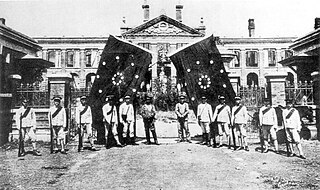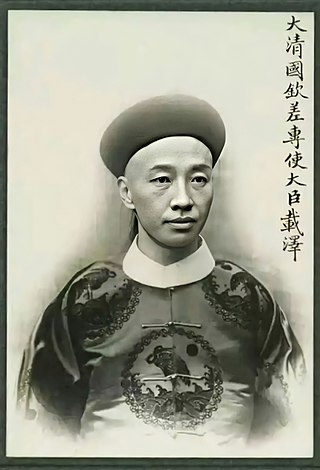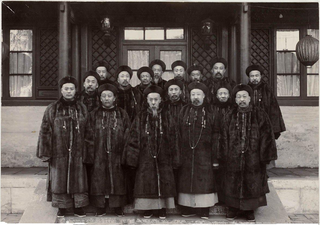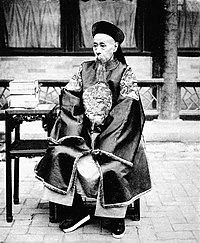
Yuan Shikai was a Chinese general and statesman who served as the second provisional president of the Republic of China, head of the Beiyang government from 1912 to 1916 and Emperor of China from 1915 to 1916. A major political figure during the late Qing dynasty, he spearheaded a number of major modernisation programs and reforms and played a decisive role in securing the abdication of the Xuantong Emperor in 1912, which marked the collapse of the Qing monarchy and the end of imperial rule in China.

The chancellor of the Republic of Austria is the head of government of the Republic of Austria. The position corresponds to that of Prime Minister in several other parliamentary democracies.

The Wuchang Uprising was an armed rebellion against the ruling Qing dynasty that took place in Wuchang, Hubei, China on 10 October 1911, beginning the Xinhai Revolution that successfully overthrew China's last imperial dynasty. It was led by elements of the New Army, influenced by revolutionary ideas from Tongmenghui. The uprising and the eventual revolution directly led to the downfall of the Qing dynasty with almost three centuries of imperial rule, and the establishment of the Republic of China (ROC), which commemorates the anniversary of the uprising's starting date of 10 October as the National Day of the Republic of China.

Inukai Tsuyoshi was a Japanese statesman who was prime minister of Japan from 1931 to his assassination in 1932. At the age of 76, Inukai was Japan's second oldest serving prime minister, after Kantarō Suzuki whose term ended at the age of 77.
The Hundred Days' Reform or Wuxu Reform was a failed 103-day national, cultural, political, and educational reform movement that occurred from 11 June to 22 September 1898 during the late Qing dynasty. It was undertaken by the young Guangxu Emperor and his reform-minded supporters. Following the issuing of the reformative edicts, a coup d'état was perpetrated by powerful conservative opponents led by Empress Dowager Cixi. While Empress Dowager Cixi supported the principles of the Hundred Days' Reform, she feared that sudden implementation, without bureaucratic support, would be disruptive and that the Japanese and other foreign powers would take advantage of any weakness. She later backed the late Qing reforms after the invasions of the Eight-Nation Alliance.

The Beiyang Army, named after the Beiyang region, was a large, Western-style Imperial Chinese Army established by the Qing dynasty government in the late 19th century. It was the centerpiece of a general reconstruction of Qing China's military system. The Beiyang Army played a major role in Chinese politics for at least three decades and arguably right up to 1949. It made the Xinhai Revolution of 1911 possible, and, by dividing into warlord factions known as the Beiyang Clique, ushered in a period of regional division.

Zaifeng, also known as Tsai Feng, Prince of Ch'ün, formally known by his title Prince Chun, was a Manchu prince and regent of the late Qing dynasty. He was a son of Yixuan, the seventh son of the Daoguang Emperor, and the father of Puyi, the Last Emperor. He served as prince regent from 1908 to 1911 during the reign of his son until the Qing dynasty was overthrown by the Xinhai Revolution in 1911.

Yikuang, formally known as Prince Qing, was a Manchu noble and politician of the Qing dynasty. He served as the first Prime Minister of the Imperial Cabinet, an office created in May 1911 to replace the Grand Council.

The Grand Council or Junji Chu, officially the Banli Junji Shiwu Chu, was an important policy-making body of China during the Qing dynasty. It was established in 1733 by the Yongzheng Emperor. The council was originally in charge of military affairs, but gradually attained a more important role and eventually attained the role of a privy council, eclipsing the Grand Secretariat in function and importance, which is why it has become known as the "Grand Council" in English.

Cen Chunxuan, courtesy name Yunjie, was a Zhuang Chinese politician who lived in the late Qing dynasty and Republic of China.

Zaizhen, courtesy name Yuzhou, was a Manchu prince and politician of the late Qing dynasty. Romanised forms of his name include Tsai-chen, Tsai-Chen, Tsai-Cheng.

Zaize, born Zaijiao, courtesy name Yinping, was a Manchu noble of the Qing dynasty. He is best known for supporting reforms and advocating the adoption of a constitutional monarchy system in the final years of the Qing dynasty.

Late Qing reforms, commonly known as New Policies of the late Qing dynasty, or New Deal of the late Qing dynasty, simply referred to as New Policies, were a series of cultural, economic, educational, military, diplomatic, and political reforms implemented in the last decade of the Qing dynasty to keep the dynasty in power after the invasions of the great powers of the Eight Nation Alliance in league with the ten provinces of the Southeast Mutual Protection during the Boxer Rebellion.

The Cabinet of Prince Qing was the first cabinet of the Qing dynasty and of China, formed as part of the Qing state's reforms to create a constitutional monarchy in the early 20th century. It was active from 8 May to 1 November 1911, led by the Prime Minister of the Imperial Cabinet, Yikuang. It initially consisted of thirteen members, of which nine were Manchus while only four were Han Chinese. As a result, it remained unpopular among the people and was nicknamed the "Princes' Cabinet" or "Imperial Family Cabinet"(皇族内阁; 皇族內閣; Huángzú Nèigé) by its critics.

The Advisory Council, also known as the Government Advisory Council, Political Advisory Council, or Political Advisory Board, was a preparatory body for the parliament established in 1910. It was part of the New Policies in the late Qing dynasty, of which the Qing court was moving toward the implementation of a constitution. In September 1907, the Guangxu Emperor promulgated a decree on the setting up of the Advisory Council, following by the provincial Consultative Bureaus in October.
The political systems of Imperial China can be divided into a state administrative body, provincial administrations, and a system for official selection. The three notable tendencies in the history of Chinese politics includes, the convergence of unity, the capital priority of absolute monarchy, and the standardization of official selection. Moreover, there were early supervisory systems that were originated by local factions, as well as other political systems worthy of mention.

China was a monarchy from prehistoric times up to 1912, when a republic was established. The succession of legendary monarchs of China were non-hereditary. Dynastic rule began c. 2070 BC when Yu the Great established the Xia dynasty, and monarchy lasted until 1912 when dynastic rule collapsed together with the monarchical government. Various attempts at preserving and restoring the Chinese monarchy occurred during and following the Xinhai Revolution, but these regimes were short-lived and lacked widespread recognition.
The Imperial Edict of the Abdication of the Qing Emperor was an official decree issued by the Empress Dowager Longyu on behalf of the six-year-old Xuantong Emperor, the last emperor of the Qing dynasty of China, on 12 February 1912, as a response to the Xinhai Revolution. The revolution led to the self-declared independence of 13 southern Chinese provinces and the subsequent peace negotiation between the rest of Qing China and the collective of the southern provinces.

The Articles of Favourable Treatment of the Great Qing Emperor after His Abdication, also known simply as the Articles of Favourable Treatment, was an agreement drawn up by the Qing dynasty government and the Provisional Government of the Republic of China on the relevant protection measures after the abdication of the Qing imperial family and the Xinhai Revolution. The document is dated 26 December, 1914.




















